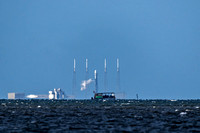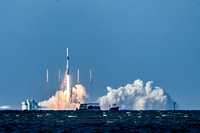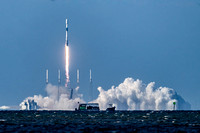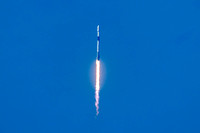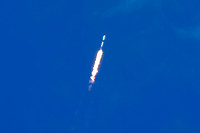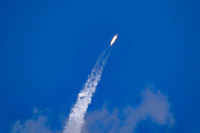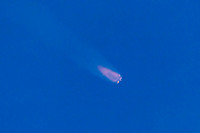Created 1-May-22
Modified 13-Dec-23
from Spaceflightnow.com...
Friday’s launch marked the fastest turnaround between flights of the same Falcon booster, breaking the previous record of 27 days.
After a smooth countdown, the Falcon 9 fired its Merlin main engines and climbed away from pad 40 at Cape Canaveral Space Force Station at 5:27:10 p.m. EDT (2127:10 GMT) Friday.
Chugging kerosene and liquid oxygen propellants, the Merlin 1D engines powered the 229-foot-tall (70-meter) rocket through the stratosphere on a trajectory northeast from Florida’s coastline.
Amid the fading rumble from the Falcon 9’s rocket engines, the first stage shut down and jettisoned, then arced to an altitude of nearly 400,000 feet before coming down for a propulsive vertical landing on the drone ship Just Read the Instructions about eight-and-a-half minutes after launch.
Like most recent Starlink missions, the Falcon 9’s upper stage placed the 53 Starlink satellites into a near-circular orbit at an average altitude of 192 miles (310 kilometers) for deploying of the 53 flat-packed spacecraft, each weighing a bit more than a quarter ton.
The second stage ignited its single vacuum-optimized engine for two burns to place the Starlink satellites into the correct orbit for separation. Deployment of the Starlink satellites occurred south of Australia about 59 minutes into the mission.
The Falcon 9 released the satellites in an orbit with an inclination of 53.2 degrees to the equator, one of five orbital “shells” used in SpaceX’s global internet network.
The Starlink satellites will extend solar arrays and use on-board ion thrusters to reach their operational orbit at an altitude of 335 miles (540 kilometers), where they will enter commercial service and begin beaming broadband signals to consumers.
SpaceX has now launched 2,441 Starlink satellites to date, including spacecraft that were decommissioned or suffered failures. More than 2,100 of those satellites are in orbit and functioning as of Friday, according to a list maintained by Jonathan McDowell, an astrophysicist who tracks spaceflight activity.
© Dennis Huff


